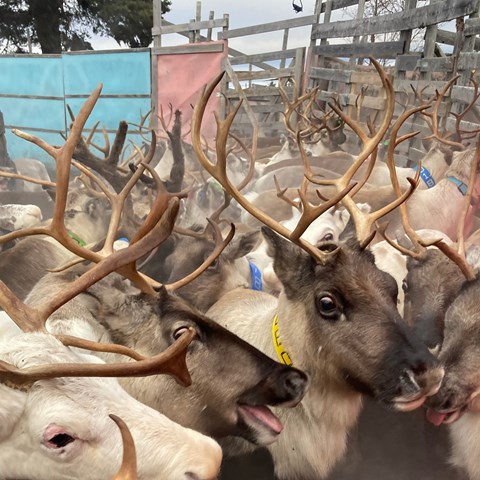Facts:
The project runs 2022-2026 and is financed by research council Formas.

Strategies for coping with challenges in a pastoral management system with increasing external pressures.
Rapid and pronounced climate change in the Arctic and Subarctic regions causes distress, challenges and economic uncertainty in the indigenous Sami reindeer herding pastoral system. The reindeer and reindeer husbandry are also affected by competing anthropogenic activities such as forestry, hydropower, wind power, mining and high number of large carnivores. All compete with reindeer land use and constrain an optimal pasture rotation.
Systems based on natural conditions and resources have strategies to cope with environmental variations, however, when the amplitude of such variations increases and stochastic events occur more often, they can push the system beyond the extreme of what is manageable or into states that has previously not been experienced. Gathering knowledge on how to mitigate these negative impacts of climate change is accordingly of urgent importance.
The goal of this project is to understand the effects of climate disturbances and exploitation on reindeer husbandry with a focus on reindeer herd productivity (reindeer condition, survival and yearly calving), so that we can better manage reindeer pastures.
In winter, the reindeer graze in the forest landscapes, and its main food is lichen. Climate change leads to increasingly warmer winters and when the temperature fluctuates between plus and minus degrees, the lichen becomes unavailable covered by a crust of ice. When the pasture is unavailable over large areas, the reindeer herd needs to find alternative grazing areas. This is often difficult as forestry has fragmented the pastures and various disturbances cause avoidance of otherwise good pastures. To avoid starvation the herder then needs to supplementary feed the reindeer, which is an enormous amount of extra work and with expensive extra costs.
In summer, many reindeer herding communities move their reindeer to the mountain range. Delayed arrival of spring in the calving area in the mountains can cause the calves to be born in the middle of winter and therefore freeze to death, which happened in the spring of 2020. In the summer, the reindeer need cooling and protection from insect attacks, such as snow patches in the mountains or cool old growth forests in the forest area, but the snow patches often dry out and the old forests are cut down.
The escalating climate disturbances of recent decades combined with increased exploitation mean that reindeer husbandry is under severe pressure, where until now there has been no data available to study the effects on the reindeer and the reindeer herd's productivity in detail.
In the REINFORCE project, we will use data on several levels. We have access to 25 years of national registers of slaughter weights and reindeer numbers from the 51 Sami reindeer herding communities in Sweden, and a unique data with 20,000 individually marked calves and their mothers collected over 40 years from Ruvhten Sijte reindeer herding community in Härjedalen. We also want to simplify the possibility of using production data on a daily basis in reindeer husbandry by evaluating a digital individual marking system, which can help reindeer herders to adapt the reindeer herd to future climate changes. This is done through interviews and workshops with reindeer herders in Sweden and Norway.
Anna Skarin, anna.skarin@slu.se
The project is a collaboration between participating reindeer herding communities and reindeer owners in Sweden and Norway, the Sámiid Riikkasearvi/SSR (the National Union of the Swedish Sami People), the Sami Parliament and a number of researchers at SLU and other universities – Prof. Anna Skarin, Prof. Emeritus Birgitta Åhman and Léonie Duris at the Department of Animal Nutrition and Management , SLU, Prof. Lars Rönnegård, Dalarna University, Docent Per Sandström and Docent Sven Adler at Department of Forest Resource Management, SLU, Prof. Øystein Holand at NMBU, Norway and Dr. Torkild Tveraa, senior researcher at NINA, Norway.
The project runs 2022-2026 and is financed by research council Formas.